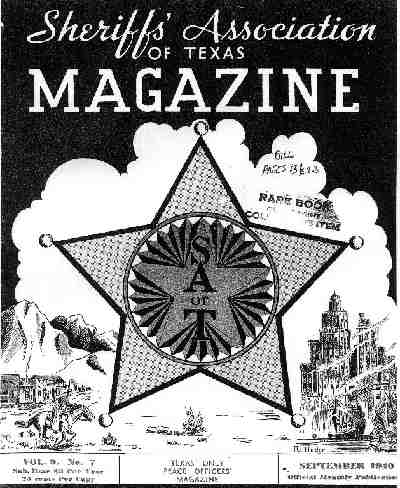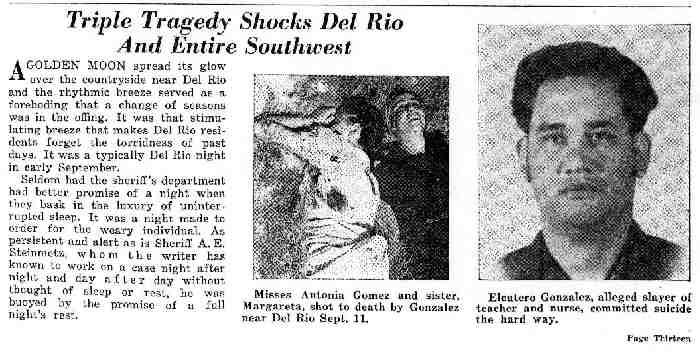
|
 |

|
|---|
Del Rio, Tragedy - I


SHERIFFS’ ASSOCIATION OF TEXAS MAGAZINE
“Triple Tragedy Shocks Del Rio And Entire Southwest” – Sept 1940 (page 13)
GOLDEN MOON spread its glow over the countryside near Del Rio and the rhythmic breeze served as a foreboding that a change of seasons was in the offing. It was that stimulating breeze that makes Del Rio residents forget the torridness of past days. It was a typically Del Rio night in early September.
Seldom bad the sheriff's department had better promise of a night when they bask in the luxury of uninterrupted sleep. It was a night made to order for the weary individual. As persistent and alert as is Sheriff A. E. Steinnmetz, whom the writer has known to work on a case night after night and day after day without thought of sleep or rest, he was buoyed by the promise of a full night's rest.
And about the time the bloodhounds in the Steinmetz kennels had ceased finding shadows at which to bark, the occupants of the jail had turned in, as had the several deputies, always on hand in the rooms beneath the jail, stark tragedy was taking place almost within sound of the portals of the antiquated Val Verde county jail. Two lives were being snuffed out as wantonly as if they were in the wake of the Hitler blitzkrieg, and a third person, a mad man, a man bereft of all reasoning, was embarking on the road to eternity. But the tragedy was to remain a secret until eight hours later when discovery of the first two victims was made by Presley Penn, a truck driver.
The victims were Antonia and Margareta Gomez, sisters, the former a 34-year-old school teacher who had served in the schools of San Felipe, the Spanish suburb of Del Rio, for the past eight years, and the latter, 23 years old, a nurse who had recently graduated from the Santa Rosa hospital of San Antonio.
The third victim, Eleutero Gonzalez, about 30 years old, who subsequently died of self-inflicted wounds, according to the coroner's findings, is alleged to have slain the two sisters about six miles from Del Rio on the Eagle Pass highway, which parallels the Rio Grande. The young women .were shot to death with an antiquated revolver.
The killer, probably maddened in the realization of the magnitude and horribleness of his crime, cut his own throat, slit his stomach, severing several intestines and stabbed himself near the heart several times, and was found thirty hours later in a semiconscious condition, decomposition already having set in, as life held on by a tender thread. He succumbed about ten hours after being taken to a hospital without regaining consciousness except to gasp weakly that he wanted water.
A tranquil and law-abiding community was shocked to the realization that crime in all its heinousness had visited it, and from the start, about 10 a. m. the day following the murder of the young women, Sheriff A. E. Steinmetz and his staff threw everything they had into the case.
When Truck Driver Penn brought word to the sheriff's department at Del Rio he contacted Chief Deputy W. T. Dawson who with Bill Strickland, Texas Liquor Board inspector stationed at Del Rio, and Justice of the Peace J. P. Aderhold rushed to the scene. In a few minutes Deputy Calvin Wallen was on the scene to be followed shortly thereafter by Sheriff Steinmetz with his three bloodhounds.
The usual inquest was held and the verdict was that the girls came to their deaths as the result of gunshot wounds inflicted by a person or persons unknown. The bodies were then taken to a Del Rio mortuary, while a man hunt such as only the Del Rio sheriff's department is capable of conducting, got under way. Rest, and even meals were forgotten as noon passed and finally the afternoon gave way to eventide. Midnight came and the hunt continued and lasted until after the sun had filtered through the dense shrubbery that makes the Del Rio community so attractive.
The hounds were unable to pick up the scent and were called in. Meantime officers who had been joined by A. C. Kennedy, fingerprint expert at the Border Patrol station in Del Rio, gave some attention to an antiquated revolver which lay on the seat of the car which the two young women victims and the alleged slayer had occupied. To find the owner of this weapon was no easy assignment, especially in a close-mouthed community like that surrounding Del Rio. Deputy Wallen and the rest of those in the case began devoting much attention to the task of identifying the owner of this unusual weapon which clearly was the gun used in the killing of the women. The owner was finally found and admitted the weapon was his. A man, Gonzalez, in fact, had gone to his home on the night of the murder and sought to borrow the gun. The owner had refused but after Gonzalez left the gun owner said his revolver was missing, so he concluded that Gonzalez had stolen it.
Meantime, Sheriff Steinmetz and his force, which had been considerably augmented by members of the U. S. Border Patrol, covered the terrain near where the bodies were found, on horseback and afoot.
The sheriff, members of his force, and the border patrolmen realized their big task was to guard the banks of the Rio Grande and thus prevent the killer from escaping into old Mexico. The spot where the girls were killed is in open ranch country with few houses anywhere near it. The Eagle Pass highway parallels the Rio Grande and this famous stream is thickly fringed with heavy timber and undergrowth, thus affording excellent shelter and protection for a fugitive. In view of this, it was believed the slayer would make an attempt to elude his pursuers and cross into Mexico.
As daylight succeeded darkness, a spot on the ground was discernible at one or two places and the officers believed the splotch had been caused by oozing blood. The search went on until after sun-up when Sheriff Steinmetz and Deputies Dawson and Schrier came abruptly upon Gonzalez lying on the outside of the ranch fence, not more than three-quarters of a mile from the scene of his crime.
"For two days I remember nothing," replied Gonzalez weakly, when Sheriff Steinmetz asked him if he killed the two women. He was barely conscious and was able to utter a faint plea for water before lapsing into a coma.
Gonzalez was hurried to a Del Rio hospital where emergency treatment was administered under the scrutiny of a guard posted by the sheriff's department. He died a few hours later without making a statement. He was literally sliced to bits about the abdomen, around the heart and about the throat.
As attention shifted to other angles of the case, it was learned that Gonzalez bad been a roomer at the Gomez home for the past several months, that he had kept company with Miss Gomez, the teacher, and acquaintances regarded the association of the couple as foreboding marriage. No trouble had ever been known to exist from the association of Gonzalez and the teacher, who was highly respected in the Del Rio community, had taken an active part in Girl Scout work and whose family likewise was held in high esteem.
The only thing officers knew about the habits or conduct of Gonzalez was that he had, earlier in the year, been sentenced to a long penitentiary sentenced upon conviction of rape, the victim being a 12-year-old Mexican girl. A new trial failed to shorten the sentence and at the time of the latest tragedy Gonzalez was free on bail pending another appeal.
A further check of the movements of Gonzalez on the night of the murder indicated he had borrowed an automobile which he used for some time before returning it to the owner. He had emerged from the borrowed car and climbed into the dark colored coupe in which the two Gomez girls were supposed to be riding. Their bullet-ridden bodies were found about four miles from the home of the borrowed car owner and it is believed the tragedy occurred shortly after Gonzalez had returned the car.
The bodies of the two victims were found lying beside a 1936 Chevrolet coupe, and the belief prevails that Gonzalez had forced his victims from the machine before firing shots from the heavy calibrated revolver into their bodies. Each victim had been shot twice but there were few blood spots on the ground, indicating internal bleeding.
Fingerprints and other evidence coincided with the opinion of officers that Gonzalez, aroused through jealousy or hatred, or perhaps under the maddening influence of strong drink (Continued on Page 16) or marihuana, took the life of his sweetheart and her sister.
Realizing later the ghastliness of his crime and fearful of the punishment that assuredly awaited him through the operation of justice, Gonzalez may have decided to end it all the hard way.
A knife purchased by Gonzalez at a Del Rio store the day of the killing and which officers believe was used to inflict the mutilating wounds that caused his death, has never been found. Sheriff Steinmetz is continuing the search as are his deputies, and some day, sooner or later, the knife will turn up, the sheriff believes.
Indications are that Gonzalez wandered around in the field for hours following the killing, but the condition of his wounds, infected and partly decomposed when found, indicates that not many hours elapsed after the double slaying until he plunged the newly-acquired knife into his vitals.
The case was one of the most brutal that Del Rio has seen in many years even among the highly temperamental and warm - tempered Spanish residents. Its quick solution is a credit to the untiring efforts of Sheriff Steinmetz and his force of deputies and assistants.
WANT TO KNOW MORE:
=====================
Due to space / download time considerations, only selected materials are displayed. If you would like to obtain more information, feel free to contact the museum. All our material is available (at cost) on CD-Rom format.
CONTACT PAGE
TEXAS  BACK TO MAIN PAGE |
 ON TO PART II ELEUTERO GONZALEZ |